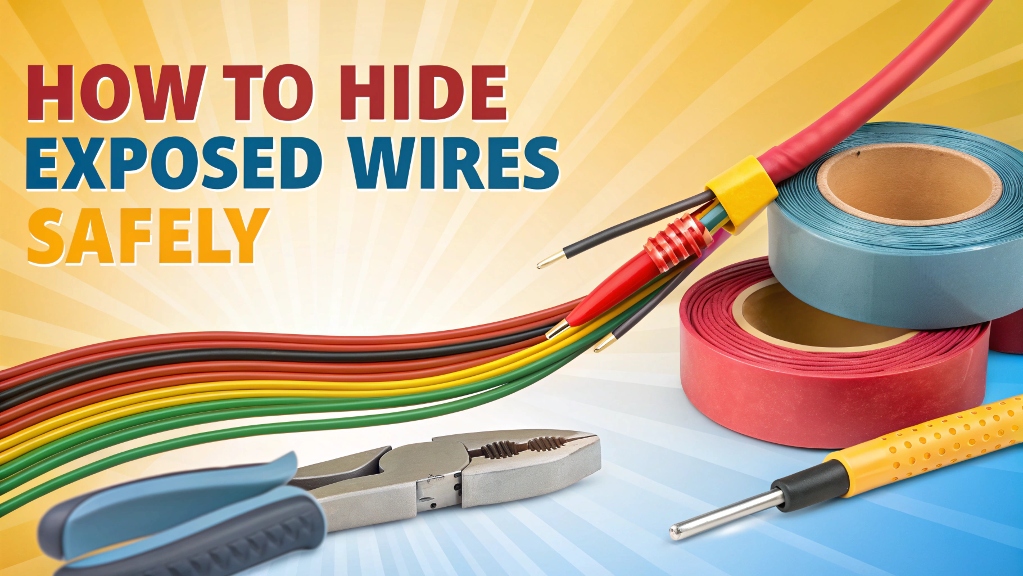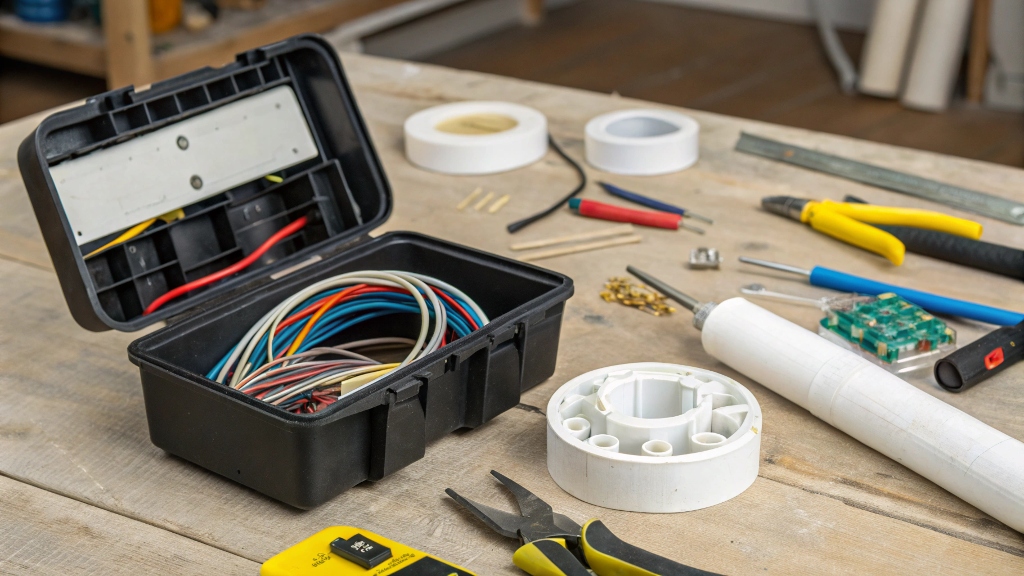
Walking into my living room, I once tripped over a mess of exposed wires snaking across the floor. It was a wake-up call—those cables weren’t just an eyesore but a safety hazard. Hiding exposed wires safely is crucial for a tidy, secure home. Whether it’s for aesthetics or preventing accidents, addressing this issue can transform your space. According to the National Fire Protection Association (NFPA), electrical issues cause over 45,000 home fires annually in the U.S. This blog post shares practical, safe ways to manage exposed wires, blending my experience with expert tips. Let’s dive into creating a safer, cleaner home environment.
Why Hiding Exposed Wires Matters
Exposed wires are more than a visual nuisance; they pose real risks. Tripping hazards can lead to injuries, especially in homes with kids or pets. Additionally, uncovered cables may fray, increasing the chance of electrical shocks or fires. The NFPA reports that faulty wiring accounts for 7% of home fires, emphasizing the need for action.
Hiding wires safely enhances your home’s appearance and protects your family. My close call with a loose cable spurred me to act, and the difference was night and day. By organizing wires, you reduce clutter and create a polished look. This section explores practical reasons to tackle exposed wires and sets the stage for safe solutions.

Assessing Your Wire Situation
Before hiding exposed wires, evaluate your setup. Start by identifying all visible cables—think TV cords, computer wires, or lamp cables. Check for wear, fraying, or damage, as these require immediate attention. According to the Electrical Safety Foundation International (ESFI), damaged cords cause thousands of injuries yearly.
Next, consider your goals: safety, aesthetics, or both? In my case, I wanted a clutter-free living room without risking shocks. Map out where wires run and note high-traffic areas to avoid tripping hazards. This step ensures you choose the right tools, like cord covers or clips, for a tailored solution. Planning ahead saves time and keeps safety first.
Tools You’ll Need
- Cord covers: Conceal wires along walls or floors.
- Cable clips: Secure cables neatly in place.
- Zip ties: Bundle loose wires for organization.
- Electrical tape: Insulate minor frays (replace heavily damaged cords).
Safe Methods to Hide Exposed Wires
Using Cord Covers for a Professional Look
Cord covers are a game-changer for hiding exposed wires safely. These plastic or rubber channels stick to walls or floors, encasing cables neatly. They blend with decor and prevent tripping. The ESFI recommends cord covers to reduce electrical hazards in homes.
In my apartment, I used adhesive cord covers to hide TV cables along the baseboard. Installation was simple: measure, cut, and stick. The result was a sleek, safe setup. Choose covers that match your wall color for a seamless look. However, ensure proper ventilation to avoid overheating. This method is affordable, effective, and renter-friendly, making it ideal for most homes.
Cable Clips and Organizers for Small Spaces
Cable clips are perfect for tight spaces or minimal setups. These small adhesive holders secure wires to furniture or walls, keeping them out of sight. They’re inexpensive and easy to install, ideal for desks or entertainment centers.
I used clips to tame my desk’s cable chaos, securing charger cords behind my monitor. It took minutes and transformed the space. Opt for clips with strong adhesive to handle heavier cables. Additionally, bundle excess cords with zip ties for extra tidiness. This approach keeps wires safe and organized without permanent changes, perfect for temporary setups.
Concealing Wires Behind Furniture
Rearranging furniture can hide exposed wires without extra tools. Positioning a couch or bookshelf strategically covers cables running along walls. This method is cost-free and effective for renters wary of adhesives.
In my living room, I shifted a console table to hide speaker wires, instantly improving the look. Ensure furniture doesn’t pinch or damage cables, as this could cause fraying. Check periodically for wear, especially in high-traffic areas. This simple trick enhances aesthetics while keeping wires safe and accessible for future adjustments.
Safety Tips for Managing Exposed Wires
Safety is paramount when handling exposed wires. Always unplug devices before working with cables to avoid shocks. Inspect cords regularly for damage, as frayed wires increase fire risks. The NFPA advises replacing damaged cords immediately rather than taping them.
Use only UL-certified products, like cord covers or surge protectors, to ensure quality. In my experience, investing in certified tools gave me peace of mind. Avoid overloading outlets, as this can overheat wires. Additionally, keep cables away from heat sources like radiators. These precautions minimize risks and ensure your wire-hiding efforts are both safe and effective.
Creative Solutions for a Stylish Finish
Hiding exposed wires can also be a design opportunity. Decorative cord covers, like fabric-wrapped options, add flair while concealing cables. Alternatively, use wall art or plants to disguise wires creatively. These touches elevate your space’s aesthetic.
I draped a decorative vine over a cord cover, blending it with my room’s bohemian vibe. It was functional and stylish. You can also paint cord covers to match walls for a subtle look. However, prioritize safety—ensure creative solutions don’t compromise ventilation or accessibility. Experiment with designs that reflect your style while keeping wires safely hidden.
Common Mistakes to Avoid
One common error is ignoring wire condition before hiding them. Damaged cords, if concealed, can spark fires. Always inspect and replace faulty cables first. Another mistake is overloading cord covers, which can cause overheating.
I once crammed too many cables into a single cover, only to notice heat buildup. Spreading them out solved the issue. Additionally, avoid using non-certified products, as they may not meet safety standards. The ESFI warns against makeshift fixes like duct tape, which can degrade. By planning carefully and using proper tools, you’ll avoid these pitfalls and ensure a safe setup.
Conclusion
Hiding exposed wires safely transforms your home’s look and protects your family. From cord covers to creative decor, these methods are practical and accessible. My journey from a tangled mess to a sleek setup taught me the value of planning and safety-first tools. By addressing exposed wires, you reduce risks like tripping or fires, as noted by the NFPA’s fire statistics. Take the first step today—assess your wires and choose a method that suits your space. Share your wire-hiding tips in the comments or spread this guide to help others create a safer home!
Read More Also: Sleep Haven Makeover: Elevate Your Bedroom Aesthetic!
FAQs
How can I tell if my wires are unsafe?
Inspect wires for fraying, cuts, or exposed metal. Replace damaged cords immediately to avoid shocks or fires.
Are cord covers safe for all types of wires?
Yes, UL-certified cord covers are safe for most household cables, but avoid overloading them to prevent overheating.
Can I hide wires without damaging walls?
Absolutely, use adhesive clips or rearrange furniture to conceal wires without permanent changes.
How often should I check hidden wires?
Check every six months for wear or damage, especially in high-traffic areas, to ensure safety.
What’s the cheapest way to hide exposed wires?
Repositioning furniture or using zip ties to bundle cables is a cost-free, effective solution.
Tried hiding your wires? Share your tips or ask questions in the comments! Don’t forget to share this guide with friends for a safer, tidier home.
Discover More: How to Soundproof Your Garage Workspace: A Quiet Haven for Productivity





